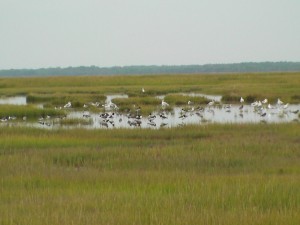American Oystercatcher – Update on a Species of Special Concern
Latest research filling in the blanks!
By Alfred Breed, CWF Field Technician
Because of the small amount of research undertaken when compared to other more intensely studied bird species, we are still very far from a complete understanding of the American oystercatcher. For several years staff from Conserve Wildlife Foundation of NJ, along with other partners throughout the state have collected data for both breeding and wintering populations of American oystercatcher in New Jersey. Very little data has been collected, however, during the non-breeding/migratory season.

That data gap is now beginning to close. Thanks to a grant provided by the National Fish and Wildlife Foundation, CWF was able to conduct surveys during the post-breeding/migratory season on roosting flocks of American oystercatcher at southern New Jersey Atlantic coastal inlets from Brigantine to Cape May. This data, when combined with data collected by other researchers range-wide, helps us to discern life-span, survival rates, movement patterns, population numbers, age structure and other important characteristics vital to our better understanding of this species.
For this study research staff surveyed inlet flocks of American oystercatchers between late July and early December 2010. Flocks were counted and observed for banded birds. There were just over 400 individual band resights during the survey period, significantly increasing our database of resighted birds. The majority of birds that were resighted were banded in New Jersey, although a number of birds banded in other states were also observed, including from Massachusetts, Delaware, Virginia, Georgia, North Carolina, and South Carolina.
Preliminary analyses of band resights and flock counts suggest seasonal patterns of behavior and show a variety of migration strategies within the species. Some migrants were sighted only once and seem to be passing through relatively quickly en route to roost sites further south. Some individuals resighted here in New Jersey were subsequently resighted a short time later on the Florida Gulf Coast at Cedar Key, indicating impressive migration distances covered in a very short time.
Others banded oystercatchers where resighted during the survey more than once here in New Jersey and spent considerable time roosting at or near our southern coastal inlets before moving on as temperatures dropped towards the end of the survey period. Still others were present during the entire period. New Jersey is the northernmost extent of the wintering range for the Atlantic Coast population of oystercatchers.

During the survey period, Brigantine, Great Egg Harbor, Corson’s, and Townsend’s inlets all showed a gradual increase in oystercatcher numbers to their peak flock counts towards the middle and end of October, when migrants headed for warmer latitudes and winter residents consolidated into New Jersey’s two primary winter flocks at Absecon and Hereford Inlets. These two primary winter roost sites had their flock counts gradually increase to their peak counts shortly before the end of the survey period. Between 350 and 400 birds were seen in each of these flocks at their peak.
As the primary surveyor for CWFNJ, one unexpected discovery I made early in the survey period was the identification of several alternative high-tide roosting sites at vernal marsh ponds close to, but some distance from, the inlets, and away from previously recorded roost site locations. Further research may help clarify if these alternative sites are a normal part of early migratory oystercatcher habitat, or are in response to the documented high levels of human disturbance in their normal roosting locations during the tourist season. Birds were observed regularly feeding at these ponds during the high-tide roost. It is possible that early in migration season the birds are still actively building reserves of energy to take them safely through the winter, and inhabit the vernal ponds to be close to an easily accessed food source. Wintering flocks, in contrast, are less likely to be seen feeding during the high-tide roost, and more likely to assume their energy conservation pose, standing on one leg with bill tucked under a wing, and the other leg drawn up tight beneath the body, with little or no feeding activity observed.
As fall progressed and human disturbance tapered off to some degree, the flocks did move to their more traditional roost sites, which are generally the beaches, sandbar islands and bayside sandflats of our inlets. Frequent shoulder-season human disturbance of the roosting flocks in these areas from watercraft users, beach walkers, anglers, ORVs, and dogs warrants additional systematic quantitative assessment and analysis for possible negative effects on the survival rates of migratory oystercatchers. Such analysis will aid in the evaluation of the need for the implementation of habitat management actions to mitigate any negative effects discovered.
The American oystercatcher precariously inhabits a narrow ribbon of coastal habitat which is also used by many other threatened and endangered plants and animals. It thus has strong potential as a “sentinel species” to help us to gauge both the current health of our ecosystem and the success or failure of habitat management actions undertaken. Continued data collection and analysis will enable us to take science-based steps in our efforts to understand the American oystercatcher, and to preserve and protect the beautiful barrier-island beaches, bays, and adjacent tidal marsh that make up our southern Jersey Shore.
Discover more from Conserve Wildlife Foundation of NJ
Subscribe to get the latest posts sent to your email.